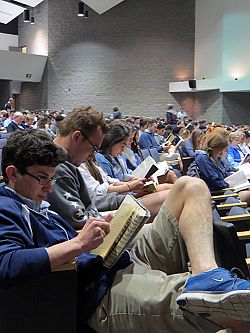High school program encourages leisure reading
Friday, Apr. 07, 2017

IC photo/Alex Harrington
+ Enlarge
The Juan Diego Catholic High School student body and faculty pore over their books during their daily 30-minute independent reading time.
DRAPER — Since the beginning of the school year, Makayla Lund has read 25 books. Reading 25 books in eight months is a great feat for almost anyone, but for Lund, a senior at Juan Diego Catholic High School, it represents a complete change. Before the school introduced a program that sets aside 20 minutes each day strictly for reading, “I didn’t read at all,” she said.
Now, however, she not only reads consistently inside and outside of school, but she can enthusiastically describe the characters and plot of her most recent book, Everything, Everything, by Nicola Yoon.
Lund’s metamorphosis into an enthusiastic reader came about despite her apprehension when she first heard about the reading program, she said. “They were going to extend the school day by four minutes, but I ended up liking it.”
Now, she thinks the reading program is “super important, because it gives you time to read and reflect,” she said. “It’s good down time; it gives you time to de-stress in the day.”
The reading program’s goal is not to force students to read but rather to give them an opportunity to fall in love with books, said Dr. Galey Colosimo, JDCHS principal. “With the onslaught of technology, student leisure reading has really declined … students really weren’t reading much outside the classroom. We saw that as a dangerous trend.”
The traditional way that schools assign difficult academic reading doesn’t solve the problem, he said. “We believe the way to academic reading is through independent reading. If we drown (students) in academic reading, at the end of the day, they’ll just want to read Harry Potter,” Colosimo said.
Three years ago, this idea was put into practice through the reading program, which gathers the entire school body and faculty in the auditorium every school day to read. Each student is assigned a reading coach they meet with once a month to discuss what the student is reading.
“You’re not meeting with a teacher for a grade, … it’s just a kid and an adult talking about reading,” and provides an opportunity for the coach to suggest books the student may like, Colosimo said. He said he didn’t want the program to turn into a situation where a student felt forced to read something they didn’t like. He recalled “in the old days, if you got 20 pages into a book and didn’t like it, your teacher wouldn’t care. … What students have said (to me) is that it’s not that they don’t want to read, it’s that they don’t know what to read.”
The school has also added reading libraries in every nook and cranny, which are stacks of books that students can browse through and borrow. One of these libraries is in Colosimo’s office, where the window sill is lined with books that range from the non-fiction bestseller The Devil in the White City by Erik Larson to graphic novels like Art Spiegelman’s Maus.
The emphasis on reading has led to increased reading comprehension scores. This was an inevitable side effect, Colosimo said, because each student is now reading approximately 167 minutes a week. “I would bet, if you looked at the state average and national average, (most students) read no more than 30 minutes a week,” he said.
“We’re trying to create a culture of reading by making reading a part of what we do,” Colosimo said. “It’s kind of like training a runner who’s competing in a marathon. You don’t start the first day of training by making them run 10 miles, … you have to develop a certain amount of conditioning. It’s the same with a good reader.”
For questions, comments or to report inaccuracies on the website, please CLICK HERE.
© Copyright 2024 The Diocese of Salt Lake City. All rights reserved.
© Copyright 2024 The Diocese of Salt Lake City. All rights reserved.

Stay Connected With Us